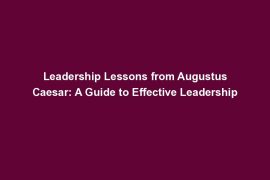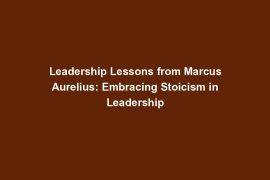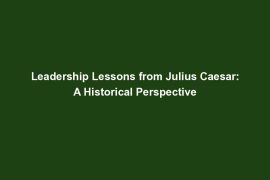Hey there, history buffs and leadership enthusiasts! Today, we’re diving into the fascinating world of Constantine the Great, a legendary figure in Roman history. But why should we care about an ancient leader like Constantine? Well, studying historical figures like him can actually provide valuable insight into modern leadership practices.
In this blog post, we’ll explore the leadership lessons we can learn from Constantine the Great. From his adaptability and flexibility in leadership to his vision and strategic thinking, there’s a lot we can glean from this iconic leader. So, get ready to uncover some timeless wisdom that can help you become a better leader in your own right.
Let’s jump in and discover the leadership secrets of Constantine the Great!
Adaptability and Flexibility in Leadership
One of the key lessons we can learn from Constantine the Great is the importance of adaptability and flexibility in leadership. Constantine was faced with a rapidly changing Roman Empire, filled with political instability, economic challenges, and religious tensions. Despite these obstacles, Constantine was able to adapt his leadership style to meet the demands of the time.
For example, Constantine demonstrated flexibility in his military strategies by employing new tactics and technologies to ensure victory on the battlefield. In the political arena, he navigated the complex web of alliances and power struggles by forming strategic partnerships and alliances to maintain stability.
Modern leaders can apply this lesson of adaptability by being open to change and willing to adjust their strategies in response to changing circumstances. In today’s fast-paced business environment, leaders must be able to pivot quickly, seize opportunities, and address challenges head-on to stay ahead of the competition.
Vision and Strategic Thinking
Constantine’s vision for a unified Roman Empire set him apart as a successful leader. He had a clear goal in mind and developed a strategic plan to achieve it. By focusing on the bigger picture and thinking long-term, Constantine was able to unite a fractured empire and establish a legacy that endured for centuries.
Today’s leaders can learn from Constantine’s example by developing and communicating a clear vision for their organizations. Having a vision provides direction and purpose, guiding decision-making and motivating employees to work towards a common goal. Strategic thinking allows leaders to anticipate challenges, identify opportunities, and stay one step ahead of the competition.
Leading by Example and Building a Loyal Team
Constantine’s personal integrity and commitment to his team inspired loyalty and dedication. He led by example, demonstrating courage, integrity, and humility in his actions. By building a strong team culture based on trust and respect, Constantine was able to achieve great things with the support of his loyal followers.
Modern leaders can take a page from Constantine’s book by focusing on ethical leadership and fostering a positive team environment. By leading by example, setting high standards, and valuing the contributions of team members, leaders can inspire loyalty and create a cohesive, high-performing team.
Conclusion: Applying Constantine’s Leadership Lessons Today
As we wrap up our exploration of Constantine the Great’s leadership lessons, it’s important to reflect on how we can apply these insights to our own roles in the modern world. By studying historical figures like Constantine, we can gain valuable perspectives on what it takes to be an effective leader in today’s complex and ever-changing environment.
Recap of Key Lessons Learned
Throughout history, Constantine demonstrated the importance of adaptability, vision, strategic thinking, leading by example, and building a loyal team. His ability to morph his leadership style to meet challenges, set a clear vision, and foster loyalty among his followers are all qualities that today’s leaders can aspire to embody.
Reflecting on Our Own Leadership Practices
Now is the time for us to pause and consider how we can incorporate these lessons into our own work. How can we be more adaptable in navigating uncertain business landscapes? How can we develop a clear vision for our teams and organizations? And how can we lead by example to inspire loyalty and dedication in those we work with?
Continuing the Learning Journey
I encourage you to keep exploring the lives of historical leaders like Constantine the Great to further enhance your leadership skills. There is much to learn from those who came before us, and their experiences can shed light on the paths we should take in our own leadership journeys. Together, let’s strive to be the best leaders we can be, drawing inspiration from the past to shape a brighter future.
Remember, leadership is a journey of constant learning and growth. Let’s continue to seek out role models and mentors from history and beyond to guide us on our path to becoming impactful and successful leaders in our own right. The lessons we’ve learned from Constantine are just the beginning of a lifelong pursuit of leadership excellence. Are you ready to take the next step?



